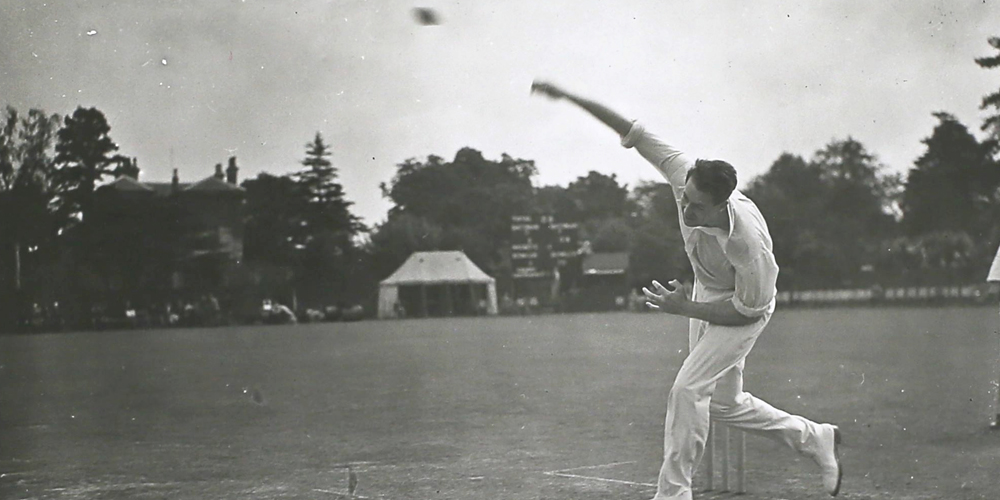
Our Cult Heroes series moves back to the pre-Second World War period and a player who was one of the countries great fast bowlers during the 1930s.
He was also featured a number of times for Cambridge University and the MCC in a career, which was brought to an end too soon. Today (Wednesday 8 July) marks his birthday and 81 years since his last season playing for the Club.
This series is supported by Allen Ford and we thank them for their continued support.
Essex Career Stats (1930-1939)
Debut: 28 June 1930 v Gloucestershire (County Championship)
Appearances: 79
Wickets: 367
Best Figures:
5 Wicket in an Innings: 28
10 Wickets in a Match: 10
Recognised as one of England’s finest fast bowlers, the life of Kenneth Farnes was tragically cut short at the age of 30 during the Second World War, his plane crashing in Oxfordshire while on a night flying practice mission.
He was born in July 1911 in Leytonstone and played in 15 Test matches from 1934 to 1939 making his first international appearance in the Ashes series against Australia at Trent Bridge. He took 60 wickets at 28.65 for England and during his 168 first-class matches, claimed a total of 690 victims at 21.45
Farnes, who played club Cricket with Gidea Park, was playing against former Essex ‘great’ P.A. (Percy) Perrin in a Club & Ground match who recognised the talent of the 6’4” paceman and directed him towards the County Club. He was called up to play for Essex against Gloucestershire a few weeks later aged only 19 and took 5-36 in his second county match against Kent at Southend although his performance was overshadowed by AP ‘Tich’ Freeman taking all 10 wickets when Essex batted for the first time.
That autumn, Ken went to Cambridge University for three years while also continuing to play for Essex as he enhanced his reputation as a fearsome fast bowler. In his last year at Cambridge, he took seven wickets in the ‘Varsity ‘match and finished with a seasonal haul of 113 victims. This included 13-98 for Essex v Somerset at Taunton and eleven wickets in the match against Surrey at Southend including 7-21 in the second innings enabling his side to claim their first success against these opponents since 1914.
He became a teacher which further limited his opportunity to play for the County although his ten matches for Essex in 1934 brought him 67 wickets at an average cost of 16.07 and Test recognition.
He was regarded as a natural successor to the great Harold Larwood and in his first Test against Australia at Trent Bridge in 1934, he took 10 wickets in the match (5 for 102 and 5 for 77) but was unable to save England from defeat.
A cartilage injury forced him to miss the whole of the season the following year but he returned as hostile as ever to win a place on the winter tour of Australia.
Taking a comparatively short and easy run, he brought the ball down from a great height with the inevitable effect of sharp lift, which made him extremely difficult to time when retaining a good length.
Clacton proved a happy hunting ground for the 6ft 5in specialist. It was there that he achieved the hat-trick against Nottinghamshire and in 1938 recorded match figures of 15 for 113 against Glamorgan, his 8 for 38 in the second innings representing the best figures of his career.
Playing in the prestigious Gentlemen v Players fixture a few weeks earlier, he had taken 8 for 43 in the first innings against the Players to point the way to only the second Gentlemen’s victory since 1914.
He played in all five Tests during the tour to South Africa that followed including the famous “timeless” Test which remained unfinished after ten days.
A very good fielder near the wicket, Farnes reached many catches that would have been impossible for a man of medium height. He had no pretension as a batsman, but in 1936, at Taunton, hit 97 not out in two hours helping Tom Wade to add 149 for the last wicket and with 6 wickets also to his name, Farnes was largely responsible for Essex winning by an innings and 66 runs.
His last summer for Essex in 1939 was another productive one for both Farnes and the county. At the end of August, the fast bowler returned figures of 6-47 at Clacton in the victory against Northamptonshire that secured fourth place for Essex in the County Championship table, their highest position since 1897.
In what proved to be a tragically short career, he amassed a total of 367 wickets at just under 19 runs each for Essex in 79 games. He played 15 times for England, taking 60 wickets at an average of 28.65.
Despite his imposing physique and aggressive pace, he was a gentle man, unmarried and interested in music and painting. He was a Wisden Cricketer of the Year in 1939 and published an autobiography, ‘Tours and Tests’ in 1940.
He joined the Royal Air Force Volunteer Reserve in the Second World War and trained in Canada. He was a Sergeant prior to being commissioned as a Pilot Officer on 1 September 1941. However, six weeks later, on October 20, he died shortly after returning to England following a night-flying exercise when the plane that he was flying crashed near Chipping Warden, Oxfordshire.
He is buried at the Brookwood Military Cemetery in Surrey.

The memorial plaque which was opened by Doug Insole at Hogg End, Chipping Warden on 20 October 2013.








